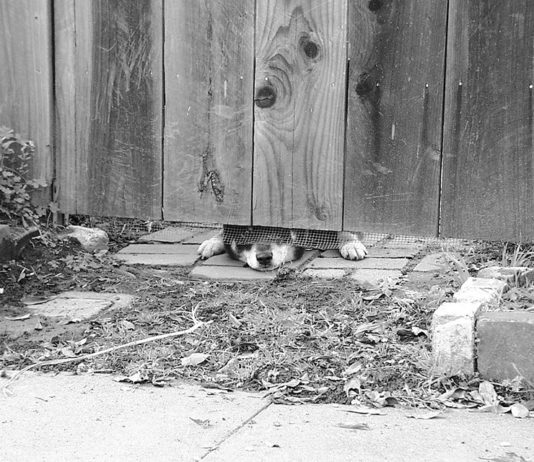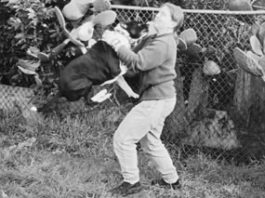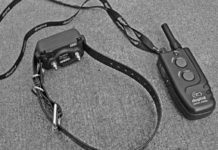Do Electric Shock Collars Harm Dogs?
Do you use an underground electric shock fence to contain your dog? Are you considering having one installed? I hope reading this will change your mind. More and more neighborhoods prohibit or limit the useof fencing, and as this occurs, the use of these non-visible electric shock perimeters has drastically increased. Manufacturers and retailers claim that these products are humane, effective means by which to safely confine dogs without disrupting the aesthetics of neighborhoods.
Tips on Stopping a Loose Dog from Approaching You
Being approached by loose dogs, especially when my dogs are on leash, is my least-favorite experience as a dog owner. When we're walking in a public place, such as a beach or park, I can usually identify the owner and ask that he please wrangle his dog. Of course, this request may be met with varying responses, ranging from appropriately apologetic for their dog having invaded our space, to accusatory, suggesting I am the problem for not allowing my dogs to roam free and socialize. But as uncomfortable as it may be to deal with unpleasant dog owners, it can be even worse to deal with a loose dog whose owner is nowhere in sight!
Why We Don’t Recommend Electric Fences (Shock Collars)
this makes many of them associate whatever they saw that drew them toward the boundary other dogs
Pros and Cons of Electric Underground Fences
Electronic fences and their partners collars that deliver an aversive agent have been around for more than 20 years. They seem like the perfect canine confinement alternative to a solid physical fence. They are often marketed as the ideal fencing solution to homeowner association fence prohibitions and for problematic, difficult-to-fence, steep, rocky and rugged living spaces. But while occurrences of a collar shorting out and administering repeated shocks to a hapless, helpless dog are relatively rare, there are other drawbacks to using electronic fencing systems. A conscientious owner will weigh all the pros and cons before deciding whether or not to invest in this sort of fencing" system. "
Living with a Difficult Dog
By your own standards, your dog’s life may not seem all that stressful – after all, he doesn’t have bills to pay, does he? But when you apply the more scientific definition of the word – anything that alarms or excites him, triggering his sympathetic nervous system into action and flooding him with the “fight or flight” chemicals adrenaline and noradrenaline – you may be able to see how many seemingly unrelated things in his environment actually contribute to his “misbehavior.”
Electric Dog Fences: Are They Safe?
One rainy day afternoon that week, upon arriving home, Darren Ashby, an electronic engineer, sent his oldest son out to the pen to take Rufus for a walk. The boy came back in and said Rufus wouldn't let the boy get near him. Dad went out to help, and was horrified by what he found. What I saw made me sick
Fighting Through The Fence
Fence aggression barking, lunging, and fence-fighting is an all-too-common canine behavior. It can also be a very difficult behavior to live with. A dog who is left for long periods of time (especially) in an enclosed yard can easily become frustrated and aroused by dogs being walked past her space and her inability to interact with those dogs. That frustration often turns into aggression, and the aggression can become very serious. Dogs can even be grieviously injured or even killed if they are able to grab another dog (or part of a dog) through a fence.
The Canine Shock Collar Debate
The chasm between those who abhor the electronic/shock collars as an abusive dog training tool and those who support and promote it as an exceptionally effective and humane training tool is so huge it will probably never be bridged. In more moderate positions in the middle of that chasm are those who believe that the collar can be an effective training tool for very limited circumstances in the hands of skilled professionals, and those who prefer not to use them but feel compelled to educate clients who insist on using them on how to use them properly.
How to Help a Leash-Reactive Dog
Beyond the human hang-ups and logistical challenges associated with a dog who now displays reactive behavior in the presence of other dogs, we must consider the impact on the dog. Reactive outbursts are the product of distress, and distress is serious business. It takes a long time for the body to recover from the jolt of hormones that happens during a distressful event. This altered brain state can leave your dog susceptible to triggers he might not otherwise react to, which is why many dogs can seem edgy" for some time following a particularly stressful event."
Why (and How) Dogs Escape Fences
The risks for a free-roaming dog are legion, including, but not limited to: getting hit by a car, shot by an irate neighbor or a police officer protecting public safety, attacking or being attacked by other animals, being picked up by animal control, or simply vanishing, never to be seen again. Yet some dogs seem hell-bent on escaping doing everything they can think of to get over, under, around, or through their humans' containment strategies. What do you do when you have a dog who is dedicated to escaping his yard?
Counter-Conditioning and Desensitization for Reducing Dog Reactvity
Counter-conditioning involves changing your dog’s association with a scary or arousing stimulus from negative to positive. Desensitization is starting with a very low-level intensity of aversive stimulus until the dog habituates to (or changes his association with) the aversive, and then gradually increasing the strength until the dog is comfortable with the stimulus at full intensity. The easiest way to give most dogs a positive association and to help them become comfortable with a stimulus is with very high-value, really yummy treats. I like to use chicken – canned, baked, or boiled; most dogs love chicken. Here’s how the CC&D process works.
9 Expert Tips for Walking Your Own Dogs
Use good equipment that is appropriate for your dog (for example, if not well trained, giant dogs probably need more than a flat collar and retractable leashes are not considered safe, ever). Inspect the fit and condition of all your equipment frequently. Ensure that your dog wears a tag with current information.














